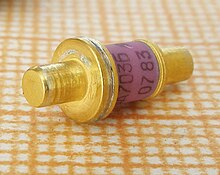
Back ثنائي قن Arabic Диод на Гън Bulgarian Díode Gunn Catalan Gunn-diode Danish Gunndiode German Diodo Gunn Spanish Gunni diood Estonian Gunn diodo Basque دیود گان Persian Diode Gunn French

A Gunn diode, also known as a transferred electron device (TED), is a form of diode, a two-terminal semiconductor electronic component, with negative differential resistance, used in high-frequency electronics. It is based on the "Gunn effect" discovered in 1962 by physicist J. B. Gunn. Its main uses are in electronic oscillators to generate microwaves, in applications such as radar speed guns, microwave relay data link transmitters, and automatic door openers.
Its internal construction is unlike other diodes in that it consists only of N-doped semiconductor material, whereas most diodes consist of both P and N-doped regions. It, therefore, conducts in both directions and cannot rectify alternating current like other diodes, which is why some sources do not use the term diode but prefer TED. In the Gunn diode, three regions exist: two are heavily N-doped on each terminal, with a thin layer of lightly n-doped material between them. When a voltage is applied to the device, the electrical gradient will be largest across the thin middle layer. If the voltage increases, the layer's current will first increase. Still, eventually, at higher field values, the conductive properties of the middle layer are altered, increasing its resistivity and causing the current to fall. This means a Gunn diode has a region of negative differential resistance in its current–voltage characteristic curve, in which an increase of applied voltage causes a decrease in current. This property allows it to amplify, functioning as a radio frequency amplifier, or to become unstable and oscillate when it is biased with a DC voltage.
© MMXXIII Rich X Search. We shall prevail. All rights reserved. Rich X Search